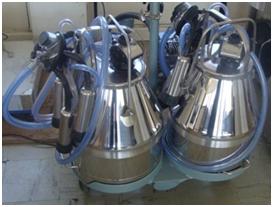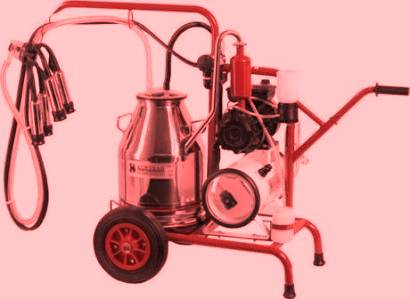Machine milking and milking machines
 Machine milking is gradually being adopted in many large farms in Kenya because it reduces labour and performs a better quality milking job than hand milking. However, because most dairy farms have small herds sizes and cheap labour farmers do not see the need to install milking machines. This is also because milking machines require power and are more expensive to install compared to the few equipment needed for hand milking.
Machine milking is gradually being adopted in many large farms in Kenya because it reduces labour and performs a better quality milking job than hand milking. However, because most dairy farms have small herds sizes and cheap labour farmers do not see the need to install milking machines. This is also because milking machines require power and are more expensive to install compared to the few equipment needed for hand milking.
But milking machines have many advantages over hand milking. For high yielding dairy cows it is normally difficult to ensure all milk is removed from the udder

Effective milking has a direct bearing on the long term milk yield of the cow. It has been proved that with time cows that are not completely milked gradually reduce milk production whereas those that are completely milked increases milk yield. The importance of complete milking therefore cannot be over-emphasized. Also note that cows cannot endure delays in scheduled milking without serious reductions in milk yield.
Although the cost of installing milking machines is high, investing in a good milking machine is a good decision if conditions allow. Many types and sizes of milking machines suitable for different categories of farmers are available in the market. Small scale farmers with small herds between 5 to 10 cows can invest on simple milking machines to replace the inefficient and labor intensive method of manual milking.
Types of milking machines
There are several types which can be broadly categorized as bucket machines and pipeline milking plants.
Bucket milking machines
These are the simplest and least expensive to install. This type of system is suitable for small and medium size herds. Cows are milked on a level floor of a stable or milking shed. The milking machine is mounted on a trolley with one or two buckets at the base. About 8-10 cows per hour are milked with one bucket type and 16-20 cows per hour with 2 buckets.
Simple hand driven mobile low cost milking machines powered by combustion engine are available in the market.
Pipeline milking plants
This set up has continuous pipeline through which milk is transported direct from the cow’s udder to a common milk reservoir. They are suitable for large dairy farms where the work load is usually heavy.
Parlour milking systems
Parlour milking systems are usually installed in milking parlourssuch as tandem and herring borne. All the equipment is centralized and the cows come to the parlour for milking.
Basic components of milking machines
Vacuum system
This comprises of a vacuum pump and reserve tank, vacuum regulator, pipelines and long pulse tube(s) forming an enclosed space.
Pulsators
These alter the vacuum level around the teat so that milking occurs without fluid congestion and edema of the teat tissues.
Milking units or cluster
The assembly of four teat cups connected to a claw and mounted with a valve that admits and cuts off the vacuum to the unit.
Milk removal system
This transports the milk away from the milking unit toward a storage unit.
How milking machines work
Although milking machines copy suckling by the calf, in a way machine milking is different from hand milking or calf suckling. A constant vacuum is applied on the teat to create a pressure difference across the teat canal and keep the machine attached to the cow. The vacuum congests the teats and squeezes milk from the teat. Atmospheric air is allowed once per second to collapse and relieve congestion around the end of the teats creating a pulsation. This pulsation is important as it massages, relieves and prevents damage to the teats.
Factors to consider when installing milking machines
Number of cows
Although you can install a milking machine for just one cow, it is not an economical undertaking. If the size of the herd ranges between 5 to 10 milking cows then the single cow milking machine is suitable. A herd size above 10 animals will require bigger sized machines.
The level of milk production
Although milking machines can be used to stimulate higher milk yields it is not justifiable to install them for a low yielding herd. Manual milking for cows that produce more than 10 litres per session is often ineffective and milking machines should be considered.
The cost and quality of manual labour
The cost of labour throughout Kenya is not high and this may not be a major consideration. Where the labour costs are high such as in developed countries, automation is necessary so as to cut costs. But skilled milkers are scarce. Those employed to milk do not do a good job, often leaving milk in the udder. Farmers can solve this problem by going for the milking machines.
Infrastructure
Most milking machines are powered by electricity so a source of power is important. But where there is no power other alternatives are available in which simple combustion engines or solar energy is used to drive the vacuum and milk pumps.
Machine milking routine practices
Machine milking is a highly skilled operation that requires continued use to be perfected. Cows develop habits. If you establish and maintain a persistent milking routine cows will feel comfortable and respond positively with a steady production. An important part of the procedure is the control and prevention of mastitis.
- Gently and calmly restrain the milking cows in the milking place.
- Ensure that all equipment and tools are clean and in proper working condition.
- Wash your hands thoroughly using clean water and soap before starting to milk.
- Clean and massage the cow’s udder and make sure the teat is dry after cleaning.
- Use individual cloths for each cow or thoroughly wash the cloth before using it to clean the next cow.
- Take a few squirts from each teat and test for mastitis.
- Use a pre dip to disinfect the outside of the teat.
- Put on the milking unit within one minute after preparation.
- Monitor the milking and adjust the unit if it starts squeaking or if the cow appears uncomfortable.
- Take off the unit when the milk flow has ceased or is very low.
- Dip the teats of the cows within one minute after take off to disinfect and protect the teat canal.
- Record your observations on the individual cows during milking.
- Separately milk treated and sick cows after all the healthy cows have been milked.
How to use a milking machine
Turn on the machineand attach the four teat-cups. When a cow finishes milking, take the cups off the cows’ teats. Some milking machines are equipped with automatic devices which sense that the flow has stopped and removes the cups. This prevents over-milking of the cow.
How to introduce machine milking into a herd
Introduce machine milking gradually by following the steps. Start by training the workforce in the procedures, milking routine, handling, cleaning and maintenance of the machine.
- Install the milking machine and modify the shed well in advance.
- From the onset be consistent with respect to the milking routine. The regular milker should carry out the machine milking during the introduction period.
- Stay with the cow to see that she is comfortable when the teat-cups are attached to the udder. Calm the cows by soft talking and massaging. The first sessions are usually more difficult but this improves with time.
- Start with heifers because they are easier to train than older cows. Older cows that have been hand milked may take time or respond negatively to a change in routine. Do not hand milk heifers and instead introduce them directly to the machine so as to get accustomed to the noise of the vacuum pump.
- Select older cows that are calm and comfortable with hand milking. Look for those with uniform udders and teats in terms of conformation and size. Do not select unhealthy cows, those in heat or those with previous milking problems.
- Bring the milking machines into the shed and let the machines run as you hand milk the selected cows. Give the cows a chance to look at the machines, smell and even taste them. This familiarizes the cows to the machines being moved around. Do this until the cows have accepted the presence of the machines.
- Repeat these steps to cows that still show signs of nervousness or stress. Some frightened or uncomfortable cows might cause major disturbances in the whole herd. Revert to hand milking those cows that have not accepted to be milked by machines after this procedure.

